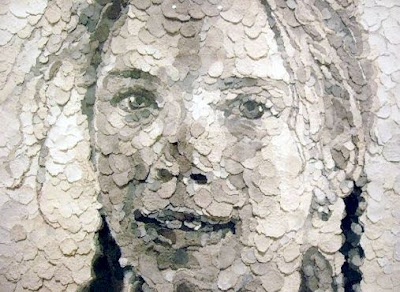
Featured here is the admirable modernist creator, Oskar Fischinger (1900-1967), an abstract painter and avant-garde filmmaker, whose non-objective “visual music” paintings, films and stills have inspired many artists, including painters, animators and filmmakers.
According to Peter Frank, "we now understand Oskar Fischinger not only as a link between the geometric painting of pre-war Europe and post-war California but as a grandfather of the digital arts."

He was a true master, coordinating symphonies of musical notes with syncopating forms, lines, colors, values, light motion and time. His work, both easel paintings and animations alike, was concerned with spatial dynamics, conveying complex perspectives, orbiting planetary bodies, buoyancy, weight, dance, and gravitational pull. Optical depth, rather than perceptual flatness, was achieved through penetrations, pulsations, saturations and resonance. The following quote briefly describes the one of his animated works, Allegretto:
“In the 1936 short Allegretto, diamond and oval shapes in primary colors perform a sensual, upbeat ballet to the music of composer Ralph Rainger. The geometric dance is set against a background of expanding circles that suggest radio waves.” – via NPR.
“Fischinger’s influence on the development of avant-garde abstract films is profound, with the genius of his vision acknowledged by 20th Century luminaries such as Orson Welles, Wassily Kandinsky, Moholy Nagy, Lyonel Feininger, Leopold Stokowski and John Cage. Fischinger's artistic innovations in film, recognized in Hollywood where he moved to work in 1936, eventually evolved exclusively into painting. In that medium he distilled his ideas in non-objective abstraction, presaging and significantly influencing Los Angeles‚ contemporary hard-edge abstract painters.” – from Arts Cenecal

“Concerned with more than mere formalist issues, Fischinger like Bauhaus master PauI Klee whom he greatly admired, sought to invoke in his abstractions Nature's operative laws. As a result, his forms in the spirit of Klee's, maintain an aura of vital forces - of growing, maturing and evolving in emulation of the powers that animate the cosmos to enter a Fischinger painting is to transcend the restraints of particular tirrie and to touch upon universals. It is this voyage he offers the viewer, launching thought visions on the winds of galactic visions into transcendent flight, that Fischinger's achievement resides.” – Susan Ehrlich Ph.D. 1988

Now, four decades after his death, one can see a select collection of his musical animations, in a recently released DVD titled, Oskar Fischinger: Ten Films, which can be found at the Center for Visual Music. Learn more about the artist at www.oskarfischinger.org.
A portfolio sampling of Oskar Fischinger’s exhibition may be viewed at the Jack Rutberg Fine Arts gallery web site.
Jack Rutberg Fine Arts
357 North La Brea Avenue, Los Angeles, California 90036-2517
Tel (323) 938-5222 Fax (323) 938-0577
E-mail,
Hours: Tuesday – Friday, 10am-6pm; Saturday, 10am-5pm




























